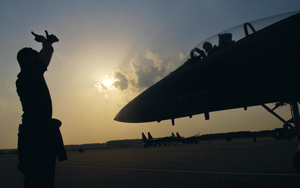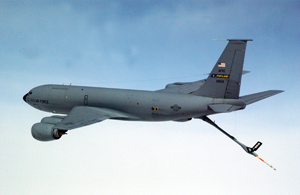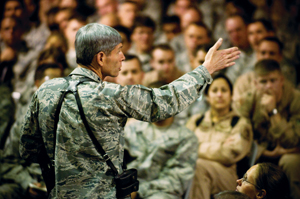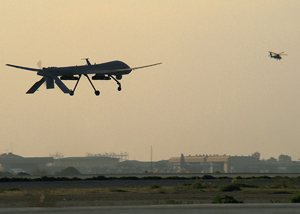A profound austerity in the coming years will bring pain throughout the Air Force, and programs that survive are likely to be low-risk projects with broad application to a wide variety of missions.
Priority will go to technologies that support the wars in Iraq and Afghanistan or provide obvious joint capabilities, while many programs seen as “niche” or those not filling a near-term need will probably have a tough time staying funded. In other words, they probably will be killed.
Such was the grim assessment delivered by top USAF leaders at the Air Force Association’s annual Air Warfare Symposium, held in late February in Orlando, Fla.
 |
At Langley AFB, Va., SrA. Ryan Rogers marshals an F-15 piloted by Capt. Matt Bruckner. (USAF photo by SSgt. Samuel Rogers) |
At the time of the symposium, many aspects of the Fiscal 2010 defense budget had yet to be worked out. Though unable to be specific in many cases, the leaders nevertheless identified some of those programs they thought were assured of continued spending.
Among them: intelligence-surveillance-reconnaissance programs, nuclear activities, airlift, a replacement tanker, and the F-35 fighter.
In almost all areas, though, the service will likely have to accept more risk, Air Force Secretary Michael B. Donley said.
Still, USAF leaders offered the hopeful observation that enforced austerity will compel the service to come up with imaginative solutions to fill the gaps.
“This is a time for us to be innovative, … to think broadly and recognize that … austerity has been the mother of invention in many instances,” Chief of Staff Gen. Norton A. Schwartz said in a press conference. The Air Force should not feel “threatened by this … but rather see this as an opportunity.” The Air Force will gladly accept “good ideas no matter where they come from.”
Donley asserted that the fiscal situation doesn’t spell doom for the Air Force.
“Just because we’re going to have more constraints on the fiscal front does not mean that we should give in to the idea that we are somehow out of airspeed and altitude,” he said. “The Air Force’s mission will continue, … and we can develop new concepts of operation for how to put combinations of capabilities that we have with whatever resources are available, to the best possible use.”
The symposium theme was “Cross-Domain Integration: Warfare in the 21st Century.”
Schwartz and Donley pledged continued commitment and funds to revitalizing the nuclear mission, although they declined to say for certain whether a new bomber still figures in service plans. Donley told reporters that the Air Force would look at new programs and what “comes after” them to see if the service could reasonably skip a generation and move on to “leapfrog technologies.”
Multirole Weapons
Even if new programs dwindle, the Air Force can squeeze more capability and effectiveness out of what it has, leaders said, particularly by integrating its own systems with those of the other services. A renewed emphasis on collaboration with allies is also in store, as international partners trade up to new capabilities.
The world economic downturn is certainly a part of the analysis of “capability, and even intent,” of potential adversaries, Schwartz said, but isn’t a factor in budget deliberations now ongoing. The details of the Fiscal 2010 budget are expected to be released later this month.
To a degree never before demanded, Air Force systems will have to be multirole-capable, Schwartz said.
“I think we’re long past the point where we can have single-mission … capabilities,” he noted. Possible exceptions might include unmanned aerial vehicles and nuclear systems, but broadly, Air Force programs will have to be useful across a range of scenarios, able to “swing from high-end, general-purpose applications to lower-end irregular warfare,” Schwartz explained.
 |
An Air Force Reserve KC-135 tanker prepares to offload fuel. With USAF’s KC-135Es grounded, the R models are being even more heavily tasked. (USAF photo) |
Conversely, in buying systems, Schwartz also said the days of requirements creep—the effort to make every system “all-seeing, all-doing, any customer”—must come to an end.
“The demand signal must be tempered,” he asserted, “and perhaps in this environment, there will be more willingness to do that.”
In his address to the symposium, Schwartz said the Air Force’s “contribution to the joint fight will likely depend upon the idea of integrated domain control, an idea broader than simply freedom of action across airspace and cyberspace, land, and maritime.” Integrating its efforts in air, space, and cyberspace can, with modest investment, provide the Air Force with far more power, he said.
The key will be command and control of capabilities in each domain, Schwartz said, in concert with other services and allies, to achieve control “at the time and place of strategic importance.” This approach will make best use of “our inherent Air Force attributes of speed, range, and flexibility in air, space, and cyberspace.”
Providing “scalable” command and control will be USAF’s stock in trade, from the smallest humanitarian relief mission to the largest theater war, Schwartz asserted.
Schwartz, formerly head of US Transportation Command, professed that a replacement tanker remains the Air Force’s highest priority, as it is for his successor in the TRANSCOM job, Air Force Gen. Duncan J. McNabb. However, an acquisition strategy has yet to be formulated on how to buy a new tanker without running into the political landmines that doomed the KC-X program last year. Donley said he hopes to have the program “back on track” this spring, with a contract award by early 2010.
The Air Force is committed to revitalizing its nuclear programs, said USAF Gen. Kevin P. Chilton, the commander of US Strategic Command, and is making solid progress in that regard. Since last year, when USAF was told to re-emphasize its stewardship of nuclear forces, Chilton said, strides have been made in toughening up inspections, broadening the scope of nuclear exercises, and in getting general officers to volunteer for roles in the nuclear mission.
Nuclear Trigger Locks
However, Chilton reiterated his unease with the fact that the US still does not have a plan to modernize its nuclear warhead arsenal.
“Of all the declared nuclear-powered nations in the world, the United States … is the only one that is not currently undertaking a modernization program for [its] weapons. This is something we must address,” Chilton said, adding that he believes it will be a central issue in the upcoming Nuclear Posture Review.
Chilton was asked to comment on a White House Web site statement that the US aims to take nuclear weapons off a “hair trigger.” Chilton said the analogy is flawed. A hair trigger, Chilton said, implies a drawn, loaded gun aimed at an enemy, where a slippery finger could create terrible consequences. Rather, the nuclear arsenal is more like a holstered gun with two trigger locks, requiring two people to unlock it.
The nuclear arsenal is “on alert,” but is safe, Chilton summed up. He said he saw no value in reducing its readiness any further. Carrying the analogy, he said a lower alert level would be like “taking the gun apart and mailing it to different parts of the country. Is that the posture we want to be in?”
 |
Gen. Norton Schwartz, Chief of Staff, talks with airmen in Afghanistan. Schwartz said that USAF seeks “good ideas no matter where they come from.” |
In the NPR, Chilton said, the key questions to answer will be, “Why do we have a deterrent, and who are we trying to deter?”
Air Combat Command has crafted a new plan to guide its choices under the new austerity. Gen. John D. W. Corley, ACC chief, detailed his new strategic plan for the combat air forces (CAF), saying it sets conceptual priorities for the years to come. It’s a strategy that will involve some inherent risk, he warned. “We’ve got to get it right,” he said, adding, “We have to know where we’re going.”
The CAF strategy calls for providing dissuasion and deterrence, decision superiority, freedom of action, and persistent pressure, Corley explained.
Dissuasion and deterrence, he said, has to do with maintaining forces powerful enough to discourage adversaries from challenging US interests or attacking the US outright. Decision superiority will mean having such comprehensive knowledge of what’s happening in the battlespace that US commanders can decide and act correctly before an enemy can. Freedom of action he defined as having the ability to control air, space, and cyberspace such that US forces can operate in any domain they please without having it taken away from their control. Persistent pressure, Corley said, ranges from the enemy knowing he is being scrutinized around the clock to keeping up a constant attack or threat of attack.
The CAF strategic plan connects to the national strategy, Corley said. It is a well-developed and sound path to guide in the face of turbulence, which includes an aging force, uncertainties of funding, the war on terrorism, and advancing technologies among peers or near-peers. He added that “turbulence can sharpen our skills … and demands that we focus, and it helps frame our expectations.”
Corley added that this is a good time to remind the nation why it needs an Air Force in the first place. Airlift and air support are not justification enough, he said, and “it is unlikely that [the Air Force] would have been born” to serve just those missions.
Rather, Corley said the nation needs air-minded professionals to “sustain a full-spectrum force” that encourages innovation, “stimulates science and technology, and strengthens partners around the globe.” The air and space instrument offers alternatives to force-on-force conflict, while working interdependently with other national capabilities, Corley said.
Air Education and Training Command will have to be quick to develop new training programs, if it’s to keep up with the accelerating pace of technological and mission change, Gen. Stephen R. Lorenz, AETC commander, told symposium attendees. Although AETC does its job well, he said, it needs to be “responsive, in a very swift time” to design courses for pop-up missions. Good examples are the inclusion of additional weeks of ground combat skills training for basic airmen who previously would not have received it, and the Air Advisor program, “started basically from nothing,” Lorenz said.
While AETC does not need to own these ad hoc programs, it can establish the overall structure of them, Lorenz said.
The Air Force “pulled” 100 pilot candidates from its Specialized Undergraduate Pilot Training program and diverted them to unmanned aircraft tracks, and Lorenz said it’s working well. The pilots are “all volunteers, … [and] they’re excited” about the program.
 |
A brand-new MQ-1 Predator drone from Joint Base Balad, Iraq, takes to the sky for the first time Feb. 13. Top officials say flexible systems such as Predator will receive funding priority. (USAF photo by SrA. Tiffany Trojca) |
We Owe Them Better
Lorenz said distance learning is being pursued as a way to provide greater professional military education opportunities even to airmen in combat zones, and cyber training will have to step up as well.
Deferring the replacement of large portions of the flying Air Force will mean more upgrades and service life enhancements, but they’ll have to come faster, Air Force Materiel Command chief Gen. Donald J. Hoffman said in a panel discussion.
Hoffman said he wants to speed up the amount of time it takes to get improvements out of the lab and into the hands of the fighting force. Part of the way to do that is to move aggressively to replace people leaving the acquisition field, he said, and to add people where possible. The AFMC civilian workforce is heavy with those either already eligible for retirement or rapidly approaching that point.
In an interview, Hoffman said he ideally wants to get equipment upgrades “in and out” within a future years defense program. To take longer, he said, is to court more problems, because vendors go out of business, or upgrades become overtaken by new technology. Toward that end, it may be necessary to “break up” upgrades into more manageable chunks, he said. Smaller programs are easier to afford and allow more of the fleet to be in a standard configuration, which helps with training and logistics.
Upgrades are taking so long, in fact, that it’s becoming almost impossible to achieve a common configuration within any fleet. There will likely be commonality “within a wing, or a block” of evolution, but probably not across an entire inventory.
Having just returned from a tour of the Southwest Asia war zone, Hoffman said that airmen are to be admired for their ability to improvise and jury-rig solutions to problems.
“MacGyver is alive and well,” Hoffman told the attendees, referring to the resourceful TV secret agent who could make ingenious gizmos seemingly from chewing gum and batteries. Hoffman reported seeing cockpits crisscrossed by wires and a bewildering array of laptop computers and other gadgets. These ad hoc approaches to obtaining better situational awareness are creative, he said, but shouldn’t be necessary.
 |
The F-22, such as this one taking flight from Elmendorf AFB, Alaska, is no longer a “new” system. The first Raptors are already a decade old. (USAF photo) |
“We owe them better,” he said.
It isn’t appreciated how old some of USAF’s aircraft are, Hoffman said in an interview. He noted that the oldest serving F-22s—the newest airplanes in the inventory—are already a decade old, and were built for about an 8,000-hour service life. That means AFMC is already having to start planning how the Raptor’s service life can be extended. It’s not an easy task, as the F-22 is the first multirole stealth fighter to reach this status, and its fine-tolerance composite body can’t be replaced with sheet metal as legacy fighters were. To slow the aging process, Hoffman reported, the F-22 training syllabus was changed about a year ago to reduce the amount of heavy-G dogfight maneuvering the pilots do, thus reducing strain on the structure.
Hoffman said that the aging-aircraft issue is in stark evidence at depots, which are finding all sorts of “surprises” in the ways that old airplanes find new ways to break, and which can’t be predicted by computer models.
Our depots are “geriatric hospitals,” he said. “The patients are coming in sicker and sicker every time.”
The new austerity will force tough choices in the coming years, Schwartz said, but he noted that “regardless of the resource constraints, … thinking is still free. Austerity is not our enemy. The inability to think creatively and ask hard, perhaps uncomfortable questions: That’s our enemy.”
|
Nukes and Cyber-War Grab Guard and Reserve Cyber and nuclear forces are areas of rising interest for the Air National Guard and Air Force Reserve Command, according to panelists discussing the future of the two Total Air Force. Cyber security certainly has attracted much Guard interest. The ANG director, Lt. Gen. Harry M. Wyatt III, said his component has good participation from leading computer and communications companies. The Guard can’t compete with the civilian salaries offered, but he noted that the desire to serve is a strong recruiting tool, and he noted one Maryland Air Guardsman has a “seven-figure” salary at his regular job, and provides invaluable expertise for the Air Force’s cyber efforts. He represents an asset that USAF probably could “never train to and never pay for.” Lt. Gen. Charles E. Stenner Jr., head of the Air Force Reserve, said his component is already involved with the nuclear bomber mission, and he would like to see it expand, although “where we get the resources to do that will remain to be seen.” Possibly, “we’ll … take some risk in other areas, or maybe there will be some additional manpower.” Be on the lookout for a widening of Air Reserve Components’ participation in almost all aspects of the USAF mission. Referring to this idea as Total Force Integration, Part II, Wyatt said he and Stenner will be working to get the Guard and Reserve to collaborate more directly, rather than just through the active force. There may be some rough spots because the two components have different cultures, but they will be worked out, Wyatt predicted. Details will be coming soon, he added, but he suggested the TFI II will represent rethinking “the construct of the entire United States Air Force.” It will include something called “embedded associates,” about which he didn’t elaborate. Stenner said the Individual Mobilization Augmentee program—in which individual reservists volunteer to augment a shorthanded staff—has been a huge success. He’s got a stack of requests for “2,200 additional IMAs on top of what we’ve got right now.” The reserves can help pay for the Air Force’s needed modernization, Stenner said. He explained that the reserve component submits an unfunded requirements list to Congress alongside the one presented by the Air Force. This National Guard and Reserve Equipment Appropriation—or NGREA—gets separate funding from Congress. The fund “gets us those defensive systems and gets us those precision engagement pieces … for the mission sets that will allow us to take the equipment that we have and get it to the war quicker,” Stenner said. His No. 1 priority is providing operational forces to the war effort while “maintaining that strategic reserve.” To keep AFRC healthy, Stenner said, he is focused on preserving the health of the “reserve triad” of members, their families, and employers, each element of which needs support if the reserve is to work. Maj. Gen. James W. Graves, assistant to the Joint Chiefs of Staff for reserve matters, said the Air Force continues to be the model for DOD’s Guard and Reserve forces, and is the most integrated of the services in this regard. The Air Force “sets the standard for total force integration … and interoperability.” To remain the standard, the reserve needs to maintain an appropriate and steady level of readiness. The other services tend to have cycles of “starvation and gluttony in terms of resources and training.” Where the reserve could improve, he said, is by making it easier to go in and out of the reserves, with less paperwork and more recognition for expertise gained in the civilian world. It could also follow the Navy’s lead in moving reservists around the force to broaden their expertise, rather than keeping them in a single function their entire reserve career. Graves also praised the Air Force for not making the same mistake the other services did, by putting all of some capabilities into the reserve. “They were terrible predictors of the future,” he said, “because those became exactly the capabilities that were needed in some other component for some other cause.” |